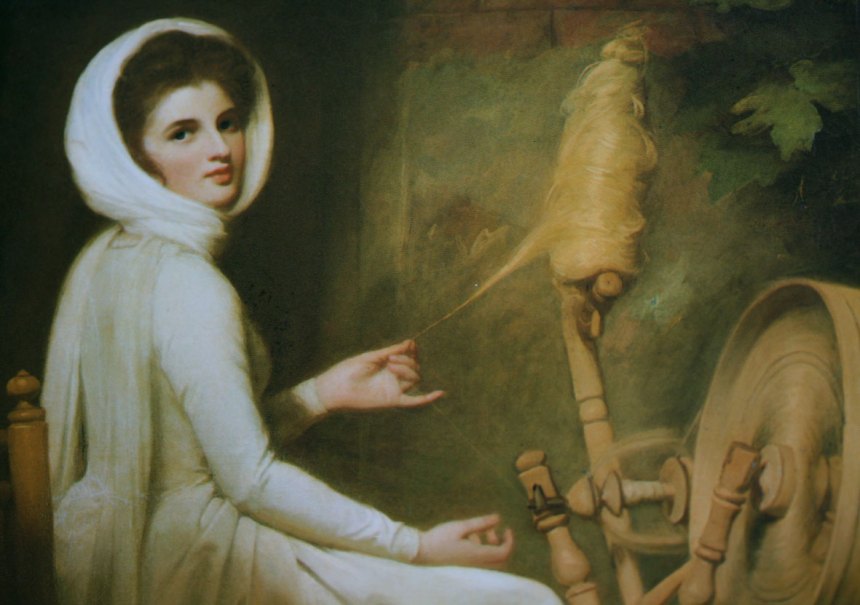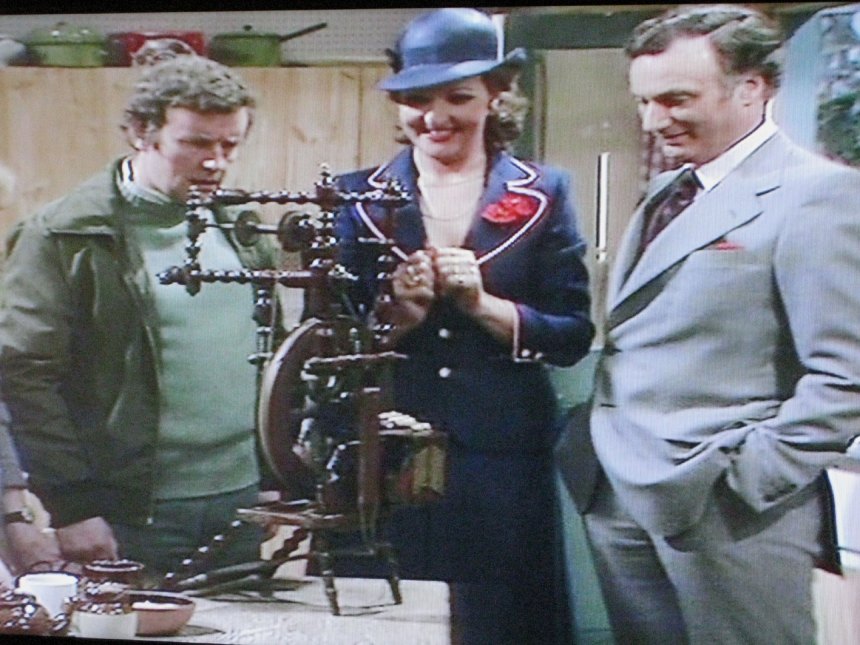I’ve been thinking about spinning since . . . well, since I had a go at it the other day. I took a lovely trip to Twist Fibrecraft with my knitting buddies, and the inevitable happened – – I returned home with a drop spindle and some satisfying packets of what Tom referred to as skyfluff, but the rest of us know as fibre. What you see above is my first couple of attempts with some icelandic and alpaca, just as it came off the spindle. Now, the spinners among you may justifiably fall about laughing at these uneven fuzzy squiggles, but to me they represent some kind of berloody miracle — I mean, I made yarn.
As I was spinning, I started thinking about this portrait of Emma Hamilton by George Romney, which has always intrigued me:

(George Romney, Emma Hamilton / the spinner (c.1785))
It intrigues me for a number of reasons: because it is Hamilton (who I always find interesting), and because she is spinning (and not paying much attention to her work). While I’m sure Emma Hamilton probably could spin, I doubt she did very much of it, and certainly not by the time Romney was painting her in the 1780s. Romney liked painting Hamilton because of her ability to be so many different types of woman — and here she is performing a particular kind of femininity for his painterly benefit. What Romney produced here is much more than a portrait of his favourite model, and more, indeed than a celebration of the virtuous, industrious, domestic woman that Hamilton is supposed to represent. The spinning wheel is an important fiction. For by the time Romney was painting this, many women’s first-hand experience of spinning would more likely to have been in the interior of a large commercial mill than sat at home at their wheel. Romney’s spinning woman sentimentalises the ideal of domestic labour on the very eve of industrialisation. She suggests the persuasive eighteenth-century fantasy of a cottage retreat from modernity.
Sentimental spinning wheels abound throughout the nineteenth and twentieth centuries. In fact, by the late twentieth century the spinning wheel’s ornamental and sentimental associations — its capacity to suggest a domestic ideal — almost entirely eroded its status as a functional object. In terms of my own experience of the 1970s domestic interior, spinning wheels were things very much like porcelain thimbles — gew gaws with which the mothers of ones more middle-class friends adorned their homes. Few of the women with wheels in the corner of their living rooms sewed or knitted, let alone spun.
Such a wheel popped up the other evening in an episode of The Good Life, which I was watching while knitting, and drinking a beer (all of which may suggest to you what it is like in my entirely un-ideal domestic interior). Margo (above, in hat) purchases an expensive spinning wheel. To Jerry (her husband, right) this is yet another useless excess, but to Tom (her next door neighbour, left) it promises the next stage in Surbiton self-sufficiency: spinning and weaving ones own clothes. After half an hour of arguments and resolutions, the wheel finally arrives. But Tom’s dreams of homespun cloth prove to be short lived — the object is not actually a spinning wheel, but a music box in the shape of a spinning wheel. In Margo’s non-functional non-wheel, what’s starting to happen in the Romney painting is taken to its logical and entirely absurd conclusion. Some of you may think I am making an obvious marxist point about the way that capitalism neatly severs the meaning of labour from the tools and objects of labour. And I probably am.



I loved that episode of “Good Neighbors”, as it is known here. That is one of my favorite old shows!
LikeLike
Your handspun looks great. I, too, am delving into the world of spin. It’s exciting to be making yarn. From fluff to yarn…it’s a kind of miracle.
LikeLike
kirsty, you’re absolutely correct, imho. fascinating.
LikeLike
I guess my last comment begs the question of whether I find ‘performed femininity’ inherently kinky?
LikeLike
Oooh, lovely handspun, it’s making me want to grab my spindle and have another go. I took a class last year and did it for a couple of days afterwards but didn’t carry on. However, lately I’ve been thinking about picking it up again, so this is another handy nudge.
I think the Hamilton painting has a slightly kinky edge about it but I’m not sure why I feel that – something to do with her gazing out at the viewer whilst delicately pinching the fibre, I think.
LikeLike
Rock on! Your first handspun looks great. I never got the hang of spindles and went straight to a wheel and we’ve been together ever since. Making yarn is such a pleasurable and deeply satisfying act of creativity – I think you just got yourself a whole new realm to play in!
LikeLike
Your first yarn is lovely. Mine was a mess, but I was so proud of it, as you say “I made yarn!” I knitted mine into a bag and felted it. It is a lovely bag. I teach beginning spinning, actually to children. I find the spinning wheel is so much easier than the drop spindle. It is so satifing to see the look on my spinners’ faces when their spinning begins to look like real yarn. I know each and every one of them experience the emotion of pride in what they have accomplished. I in turn feel pride in my students. Give a spinning wheel a try. I think learning to spin was one of the nicest things I have sone for myself.
I love the picture and the write up. Thank you
LikeLike
Congratulations on your first handspun!! May it be the begining of a wonderfull handspun stash. Now in defense of the portrait by Romney. I read while spinning lace yarn. I actually cannot look at my hands otherwise I end up messing the grist. I do the same when spinning flax from a distaf. It is like knitting in the dark, we just can feel the stitches. The same goes for spinning.
LikeLike
You went to TFC but didn’t stop off in St Andrews?!
LikeLike
Really interesting post, thanks!
LikeLike
Your first handspun are not so bad! Mine was a disaster but i learnt and i worked and now i had a wheel and i spun better than my debut. Fibers work are really addictive and when you start spinning your own yarn you’re done, you’re contaminated! And i don’t talk about dyeing process and stuff!!
I like your interpratation of this painting and even if the painting is really fantaisist i like it.
LikeLike
Nought wrong with a Marxist point.
Your first attempts look a lot better than mine did. I kept my first attempts for ages and ages – I was so proud of them. Next step …. your very own wheel :-)
LikeLike
It looks like you’re a natural! I love the warm browns you’ve used (in fact, I’m spinning brown BFL myself at the moment).
Your comments on the Romney made me think instantly of William-Adolphe Bouguereau. He was painting in the 19th century, but liked to focus on Classical characters and idealised rural scenes. Some that focus on fibre arts: Fileuse, Jeune fille au crochet, Le Travail Interrompu, Tricoteuse (1) and Tricoteuse (2). (Bet that made your spam filter sit up!) I like the unchallenging fantasy/escapism of his work, and technically I think he’s almost unsurpassed, but I’m glad that there are artists who will challenge me from time to time too.
LikeLike
Congrats on your first handspun! No one should make fun of you, everyone’s first yarn looks way weird. Mine was nuts. Yours actually looks pretty good.
Nice post. Interesting, because as an American, I would interpret the same picture in the same time frame more like Julia would have too. Except that she looks rather aristocratic and non-contemplative about her work, so the message on this side of the ocean is actually a little confusing.
LikeLike
That’s amazing – how’d you learn to ply so well? I still can’t ply any neater than that after over 5 years of spinning…
LikeLike
I am fascinated by drop spindles, my younger daughter took a class in it and it is so much fun watching her, sort if like playing with a top.
LikeLike
I’ve almost bought spindles… many times. I keep resisting because I’m afraid of having yet another time consuming fibry hobby – but I’m pretty darned close to breaking down and trying it too.
Well done, I’m inpsired by your first yarns!
LikeLike
Congratulations on your handspun – it’s lovely! I found this portrait interesting because in the American colonies at the time that painting was done, women were being portrayed spinning as a political statement – that the colonies could survive very nicely without British textiles (there was a revolution going on at the time). Not sure what to make of the Romney portrait, but it is fascinating that he chose the same subject matter with presumably a very different meaning at around the same time.
LikeLike
Absolutely nothing wrong with a Marxist point, if you ask me!
And as for your first handspun, fantastic job! It’s quite gorgeous.
LikeLike